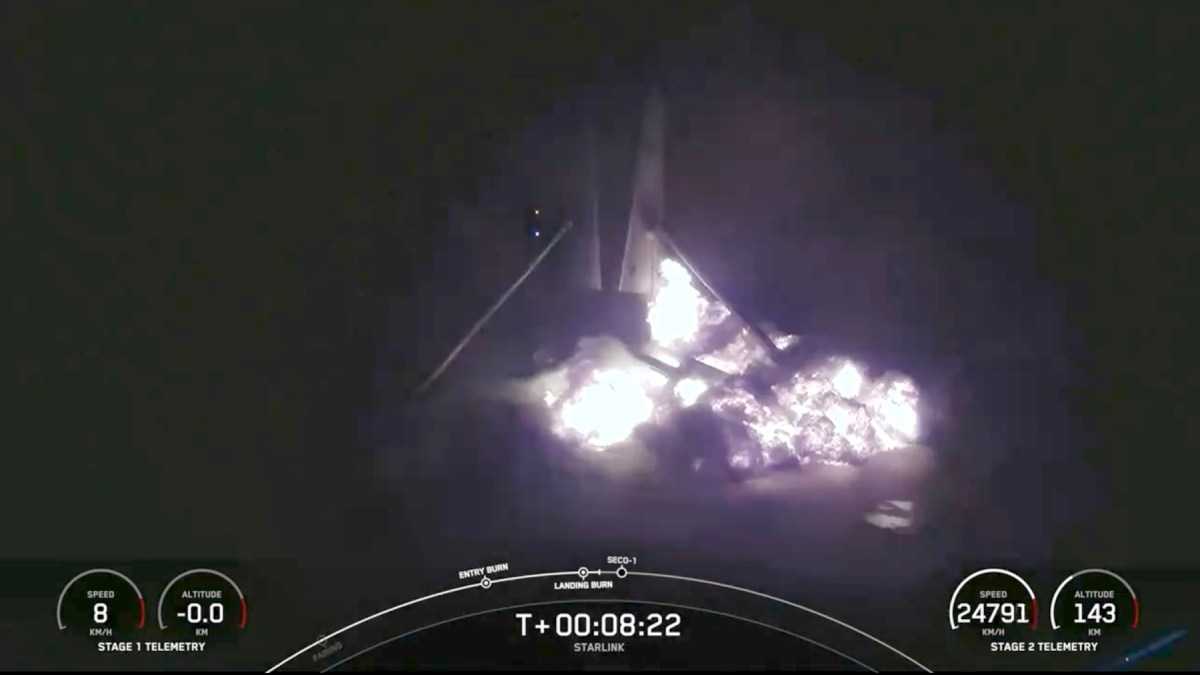WASHINGTON — A Falcon 9 booster tipped over in a fiery landing after an Aug. 28 launch, the first unsuccessful booster landing in three and a half years by SpaceX.
The Falcon 9 lifted off from Cape Canaveral’s Space Launch Complex 40 at 3:48 a.m. Eastern carrying 21 Starlink satellites. The launch itself went as planned and the Falcon 9 upper stage deployed the satellites into orbit a little more than an hour after liftoff.
The rocket’s first stage returned to make a landing on a droneship, named A Shortfall of Gravitas, in the Atlantic Ocean. The booster’s descent appeared to be normal, but upon landing eight minutes and 20 seconds after liftoff, flames erupted from the base of the booster. The booster tipped over and broke apart within 10 seconds, after which video from the droneship was cut off.
“After a successful ascent, Falcon 9’s first stage booster tipped over following touchdown on the A Shortfall of Gravitas droneship. Teams are assessing the booster’s flight data and status,” SpaceX posted on social media.
This was the fleet-leading 23rd flight of this booster, designated B1062 by SpaceX. Sixteen of those launches were of Starlink missions, with the others including the Inspiration4 and Ax-1 private astronaut missions and flights of GPS and commercial communications satellites.
The landing failure was the first for a Falcon 9 booster since February 2021. On that launch, one of nine Merlin engines in the first stage shut down early in the vehicle’s ascent. While the rocket was able to successfully deploy its batch of Starlink satellites, the booster was unable to land on a droneship. SpaceX determined that a hole in an engine cover, caused by fatigue, allowed exhaust to get into the engine and damage it.
Since that failure, SpaceX had a streak of 268 successful landings, excluding launches where the booster was expended. That includes a December 2023 launch where the booster landed on the droneship but was later swept overboard in rough seas on its way back to port.
This was to be the first of a doubleheader of Falcon 9 launches just hours apart, with a second launch planned for the early morning hours of Aug. 28 from Vandenberg Space Force Base in California, also carrying Starlink satellites. SpaceX said it was postponing the Vandenberg launch “to give the team time to review booster landing data from the previous launch.” The company did not announce a new launch date.
SpaceX announced the launch doubleheader on short notice after another delay in the launch of the Polaris Dawn private astronaut mission from the Kennedy Space Center. The launch, once scheduled for early Aug. 26, was pushed back a day last week to perform additional pre-flight checks and then another day to fix a helium leak in an umbilical line.
SpaceX announced on the evening of Aug. 27 that it was postponing the launch of Polaris Dawn at least two days, to no earlier than Aug. 30, citing unfavorable weather in splashdown zones off the Florida coast for the Crew Dragon spacecraft.
